IMPACT OF CLIMATE CHANGE
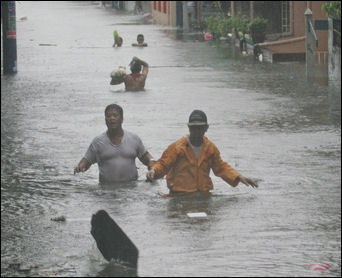
flooding from Typhoon Morakot
in the Philippines in 2009 Global warming will likely result in: 1) higher maximum temperatures and more hotter days; 2) higher minimum temperatures and fewer colder days; 3) higher heat index (heat plus humidity); 4) higher nighttime temperatures; and 5) more intense rainfall.
Some scientist predict that weather will not only be warmer it will also be wetter by 2050 as a result of climate change. Scientist at the University of Miami and University of Reading, studying 20 years of NASA satellite imagery in tropical areas, found a strong correlation between warm periods and extreme downpours. Huge storms in July and August 1998 that caused terrible floods were blamed in part on climate changes. On some days there was ten inches of rain.
The monsoons are lasting longer and normally dry months sometimes have heavy rains. Some climate change models shows an increase of intensity of the monsoons in South Asia and a shift of the monsoons to western Africa and the Sahara. Other models predict less rain. As oceans store more heat, the temperature difference between land and water decreases, draining power from the rainmaking monsoons.
Spring has been arriving earlier in many places in the United States In some places it now arrives about two weeks earlier than it used. But whenever there is a bought of severe weather the media and many people blame it on climate change. The oven-like conditions in the United States in 2011, epic floods in Pakistan and Australia, record heat waves in Moscow in 2011, the heaviest snowfall in more than a century in South Korea were all blamed on climate change. Whether that is fair or correct is a matter of intense debate.
The jury is still out as to whether it will produce more intense tropical storms and more drought. Scientists expect future hurricanes and other tropical cyclones to have stronger winds, but they won't increase in number and may actually decrease. Massachusetts Institute of Technology meteorology professor Kerry Emanuel, who studies climate's effects on hurricanes, disagrees and believes more of these intense storms will occur. Prolonged drought or damaging rains could destroy crops and cause malnutrition. Scorched soil absorbs more heat and retain less water, increasing droughts.
Extreme Weather and Climate Change
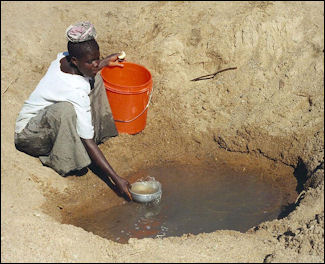
drought in Somalia In 2007, The World Meteorological Organization — the United Nations weather agency — issued a report saying that global extreme are becoming the norm. In 2006 and 2007 record high temperature were recorded in numerous places, including 90 degrees in Moscow in May and 13 F in Bulgaria in July, heavy rains and floods drove hundred of thousands from their homes and affected 500 million people and storms brought 170 mph winds to Europe, the first category 4 cyclone to the Arabian Sea and snow in South Africa.
Seth Borenstein of AP wrote in 2011, “For a world already weary of weather catastrophes, the latest warning from top climate scientists paints a grim future: More floods, more heat waves, more droughts and greater costs to deal with them. The report from the Nobel Prize-winning Intergovernmental Panel on Climate Change marks a change in climate science, from focusing on subtle shifts in average temperatures to concentrating on the harder-to-analyze freak events that grab headlines, hurt economies and kill people.” Among other things the report said that global warming could eventually grow so severe that some locations become "increasingly marginal as places to live." [Source: Seth Borenstein, AP November 1 2011]
The report said there is at least a 2-in-3 probability that climate extremes have already worsened because of man-made greenhouse gases. "The extremes are a really noticeable aspect of climate change," said Jerry Meehl, senior scientist at the National Center for Atmospheric Research. "I think people realize that the extremes are where we are going to see a lot of the impacts of climate change."
Isolated events such as freak snow storms in October in the Northeast United States cannot be blamed on climate change and probably isn't the type of storm that will increase with climate change, according to four meteorologists and climate scientists. Experts on extreme storms have focused more closely on the increasing number of super-heavy rainstorms, not snow, NASA climate scientist Gavin Schmidt said.
By the end of the century, the intense, single-day rainstorms that typically happen once every 20 years will probably happen about twice a decade, the report said. The opposite type of disaster — a severe drought — could also happen more often as the world warms, said Schmidt and Meehl, who reviewed part of the climate panel report.
Computer models indicate current climate trends will worsen existing droughts, Meehl said. Researchers have also predicted more intense monsoons with climate change. Warmer air can hold more water and impart more energy to weather systems, changing the dynamics of storms and where and how they hit. Thailand’s experience with massive flooding in 2011 from monsoonal rains shows how climate is also connected with other manmade issues such as population growth, urban development and river management, Schmidt said. In fact, the report says, "for some climate extremes in many regions, the main driver for future increases in losses will be socioeconomic" rather than a result of greenhouse gases.
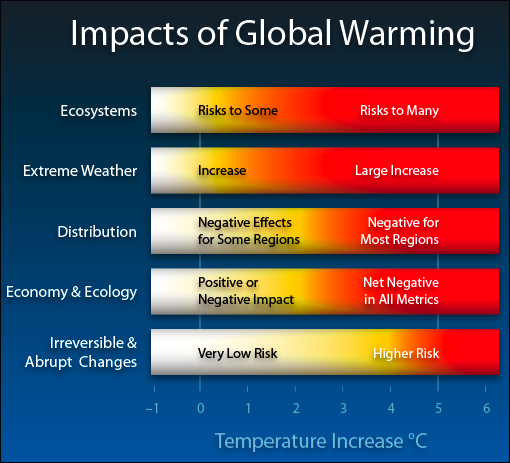
Impacts of Climate Change
The report said scientists are "virtually certain" — 99 percent — that the world will have more extreme spells of heat and fewer of cold. Heat waves could peak as much as 5 degrees hotter by mid-century and even 9 degrees hotter by the end of the century.And climate change isn't the sole villain in future climate disasters, the climate report says. An even bigger problem will be the number of people — especially the poor — who live in harm's way. The 18-page summary report isn't completely grim. It says some "low-regrets measures" can help reduce disaster risks and costs, including better preparedness, sustainable land and water management, better public health monitoring and building improvements.
Global Water Cycle Is Becoming “Increasingly Erratic and Extreme,”
The global water cycle is becoming “increasingly erratic and extreme,” with sharp swings between droughts and floods that threaten societies and economies, according to a World Meteorological Organization report issued in September 2025. [Source: Laura Paddison, CNN, September 18, 2025]
The water cycle moves water around the planet through evaporation, atmospheric transport, and precipitation — but climate change from burning fossil fuels is disrupting this system. Nearly two-thirds of river basins worldwide saw abnormal conditions last year, facing either severe shortages or dangerous excesses of water.
Many regions suffered deep drought in 2024, the hottest year ever recorded. Amazon rivers hit record lows, southern Africa faced such extreme dryness that governments planned mass wildlife culls, and crops failed across parts of the US. Heat also degraded water quality in almost all of the world’s major lakes.
At the same time, floods intensified. Europe saw its worst flooding since 2013, Hurricane Helene caused catastrophic US floods that killed more than 230 people, and West and Central Africa experienced flooding that left about 1,500 dead.
Ice loss accelerated as well. Global glaciers shrank for the third straight year, losing 450 gigatons of ice — enough to fill 180 million Olympic pools — with record melt in places like Scandinavia, Svalbard, and northern Asia. This melt drives sea-level rise, increases flood risks, and threatens regions that depend on glaciers for water and power. The economic toll is hard to quantify, but single flood events caused billions in damage, the report notes. Growing pressure on water resources can also heighten tensions and conflict.

Global Surface Temperatures in 2005
Myths about Extreme Weather
An extra one or two degrees in temperature is no big deal.Manish Bapna and Jennifer Morgan wrote in the Washington Post, “When it’s already 100 degrees outside, one degree more doesn’t seem like much. But in terms of the global average, a one-degree temperature rise has huge implications for people and the planet. Since pre-industrial times, the global average surface temperature has increased by 1.4 degrees — with more than one degree of that warming happening in the past three decades. And we are already witnessing significant changes. In many parts of the world, cold days and nights have become rarer, and hot days and nights more common, over the past half-century. And all this is happening with just 1.4 degrees of warming. What’s more, this is just an average, with actual temperatures rising at different rates, and with varying impacts, around the world. [Source: Manish Bapna and Jennifer Morgan, Washington Post, July 22 2011, Manish Bapna is interim president of the World Resources Institute. Jennifer Morgan is director of the institute’s climate and energy program]
“Hundred year” weather events happen only once every 100 years. Hundred-year weather events no longer live up to their name. In 2005, for instance, a devastating “once a century” drought hit the Amazon, only to be followed by another in 2010. Globally, previously rare weather events have been occurring with startling frequency. Consider the massive floods that inundated a fifth of Pakistan last year and submerged eastern Australia and America’s heartland this year. It’s time for meteorologists to come up with a new, more accurate term.Of course, what scientists actually mean by “one in 100 years” is not that a major flood, drought or hurricane will strike a given place only once a century, but rather that there is a 1 percent chance of such an event in any given year. Either way, the fact that what were once considered hundred-year events seem to be happening more often is consistent with climate models projecting that rising global average temperatures will lead to more frequent and severe extreme weather.
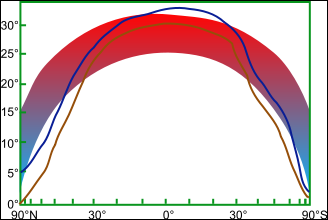
Cool tropics paradox Extreme droughts and extreme floods can’t both be due to climate change. It seems counterintuitive that climate change could be responsible for both withering droughts and devastating floods. Yet it can. Scientists have found that climate change can trigger periods of intense rainfall followed by long spells of dry weather. This combination of severe rainstorms and droughts, in turn, can lead to more flooding, landslides, soil erosion and other disasters. There are signs in some places that this may already be underway. For example, from 1951 to 2000, heavy monsoons in India became more frequent and intense, while more moderate rains happened less often. Similarly, in China, severe droughts in the spring of 2011 were followed by massive flooding, which has killed nearly 200 people and caused more than 1.5 million to be evacuated.
Dire Predictions About Future Weather
“The Weather of the Future” is a book published in 2010 that peers ahead at a world stricken by climate change. Timothy Smith wrote in the Washington Post, “Using models to predict weather patterns, climatologist Heidi Cullen, a frequent contributor to the Weather Channel, explores seven regions and their grim futures: the Sahel in Africa, the Great Barrier Reef of Australia, California's Central Valley, two sites in Greenland, Bangladesh and New York City. [Source: Timothy Smith, Washington Post, August 15, 2010]
Massive floods in Bangladesh may produce "climate refugees," Cullen suggests; New York may be battered by a Category 4 hurricane, which can have sustained winds as high as 135 miles per hour; and coral reefs may be eaten away by an acidic ocean. "These predictions and our seeming inability to heed their warning is a potential tragedy," she writes.
Cullen also predicts some geopolitical repercussions of climate change: Pirates run rampant, Osama bin Laden invokes U.S. carbon emissions to recruit terrorists, and Canada and the United States argue over naval authority in an ice-free Northwest Passage The book is at its best and most insightful when it explores today's environment, such as regreening efforts in Niger. Let models be used to predict the weather, not the politics
Climate Change and Storms
Global warming has been linked to an increase in the number of hurricanes in the Atlantic. Between 1900 and 1930 there was an average of six Atlantic hurricanes year. From 1930 to 1940 the number increased to 10. From 1995 to 2005 the average number was 15. Between 1900 and 2005 the average sea temperatures in the areas with hurricane rose 1.3 degrees F.
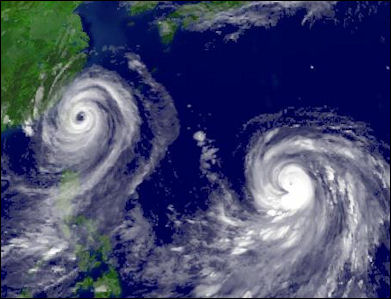
Some say storms are getting fiercer and occurring more frequently. Others say that is not true. Many scientists expect future hurricanes and other tropical cyclones to have stronger winds, but they won't increase in number and may actually decrease. Massachusetts Institute of Technology meteorology professor Kerry Emanuel, who studies climate's effects on hurricanes, disagrees and believes more of these intense storms will occur.
According to a 2010 study by the World Meteorological Organization (WMO), climate change may produce tropical cyclones that will occur less frequently but pack a stronger punch. Based on the “A1B” scenario, a middle-of-the-road commuter simulation which predicts a global average temperature rise of 2.8 degrees C, the report said “it is likely that the global frequency of tropical cyclones will either decrease or remain essentially unchanged” but winds could increase by two percent to 20 percent and rainfall could increase by 20 percent within 100 kilometers of the eye of the storm.
Stronger and More Frequent Hurricanes and Typhoons?
Some climatologists believe that the surge in the number of typhoons and hurricanes in recent years may be linked to climate change which warms up the seas and provides more energy for weather phenomena that develop into severe storms. In 1995, there were unusually high number of hurricanes. Coincidently or not, 1995 also had the highest global surface temperatures on record. and ocean temperatures in the Atlantic were the highest ever recorded. In one of the 11 years between 1995 and 2005 there were unusually high numbers of hurricanes.
There are generally more major hurricanes in years when the sea surface temperatures are higher than average. Sea temperatures in the Atlantic Ocean rose steadily from 2000 to 2004, and each of these years had an “above normal” hurricane season with the exception of 2002 which was a weak El Nino year. But the Atlantic patterns fluctuates and are not consistent. The mid 1920s through the 1960s were very active when temperatures were relatively cool. The 1970s and the early 1990s were quiet.
There was a particularly high number of typhoons in 2004. By August of that year there had already been nineteen, 35 percent more than normal. Ocean temperatures in 2004 were around two degrees F higher than normal. The year 2005 was a bad year for hurricanes. There were 27 named tropical storms — including Katrina, which killed more than 1,000 people and lef much of New Orelans and the neigboring coast in ruins’so many the list of storm names was extended with Greek letters. There were a record 15 hurricanes, including foru category 5 storms.
Super typhoons stronger than Hurricane Katrina that devastated New Orleans are expected to hit the Asia-Pacific region over the coming decades with climate change being one of the causes. Some scientist have suggested that climate change will increase the rain fall from typhoons by 20 percent and increase their winds by 10 percent. Damages is also worsening because more intense typhoons are coinciding with rising seas levels. But not all the damage is the fault of the storms. Damage typhoons is also increasing because more people than ever live on coastlines or other vulnerable areas.
Climate Change and Drought
Climate change is being blamed for drought and fires. Huge fires in Indonesia, the western United States and Alaska have been blamed in part on dryness caused by climate change. The fires also add to the global warming problem by producing more carbon dioxide and reducing the number of trees that take in carbon dioxide.
Between the 1970s and the early 2000s the amount of land on the Earth’s surface afflicted by drought has doubled. According to one study, drought-prone countries in Central Asia and Sub-Sahara are expected to be hurt the most by climate change. Temperatures in these places could rise as much a 5̊C. Global warming may cause megadroughts like the one that killed over 100,000 people in the Sahel over decades. It is also blamed for shrinking the great lakes of Africa and causing once-a-century droughts in the Amazon twice in one decade,
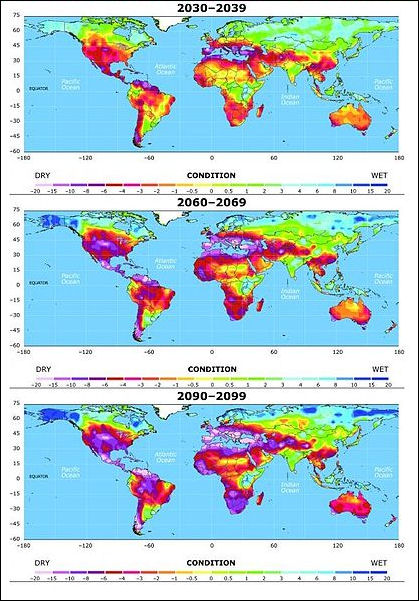
Drought Maps Stuart Grudgings of Reuters wrote, “A widespread drought in the Amazon rain forest in 2010 was worse than the "once-in-a-century" dry spell in 2005 and may have a bigger impact on climate change than the United States does in a year, British and Brazilian scientists said. More frequent severe droughts like those in 2005 and 2010 risk turning the world's largest rain forest from a sponge that absorbs carbon emissions into a source of the gases, accelerating climate change, the report found. [Source: Stuart Grudgings, Reuters, February 3, 2011]
Trees and other vegetation in the world's forests soak up heat-trapping carbon dioxide as they grow, helping cool the planet, but release it when they die and rot. "If events like this happen more often, the Amazon rain forest would reach a point where it shifts from being a valuable carbon sink slowing climate change to a major source of greenhouse gases that could speed it up," said lead author Simon Lewis, an ecologist at the University of Leeds. The research was a collaboration among scientists at the University of Leeds and the University of Sheffield in Britain and Brazil's Amazon Environmental Research Institute.
The study, published in the journal Science, found that the 2010 Amazon drought caused rainfall shortages over a 1.16 million square-mile (3 million square km) expanse of the forest, compared with 734,000 square miles (1.9 million square km) in the 2005 drought. It was also more intense, causing higher tree mortality and having three major epicenters, whereas the 2005 drought was mainly focused in the southwestern Amazon.
As a result, the study predicted the Amazon forest would not absorb its usual 1.5 billion metric tons of carbon dioxide from the atmosphere in both 2010 and 2011. In addition, the dead and dying trees would release 5 billion metric tons of the gas in the coming years, making a total impact of about 8 billion metric tons, according to the study. In comparison, the United States emitted 5.4 billion metric tons of carbon dioxide from fossil fuel use in 2009. The combined emissions caused by the two droughts were probably enough to have canceled out the carbon absorbed by the forest over the past 10 years, the study found.
The 2010 Amazon drought dried up major rivers in the Amazon and isolated thousands of people who depend on boat transportation, shocking climate scientists who had billed the 2005 drought as a once-in-a-century event. The two intense dry spells fit predictions by some climate models that the forest will face greater weather extremes this century, with more intense droughts making it more vulnerable to fires, which in turn could damage its ability to recover.
Under the more extreme scenarios, large parts of the forest could turn into a savannah-like ecosystem by the middle of the century with much lower levels of animal and plant biodiversity. Although human-caused deforestation in Brazil has fallen sharply in recent years, scientists say the forest is still vulnerable.
The jury is still out as to whether climate change will produce more drought. A crucial question is whether the droughts are being driven by higher levels of greenhouse gases or are an anomaly, Lewis said. If they are driven by climate change, a vicious cycle of warmer temperatures and droughts could conceivably lead to a large-scale transformation of the forest over a period of decades. Prolonged drought or damaging rains could destroy crops and cause malnutrition. Scorched soil absorbs more heat and retain less water, increasing droughts.
Climate Change and Agriculture
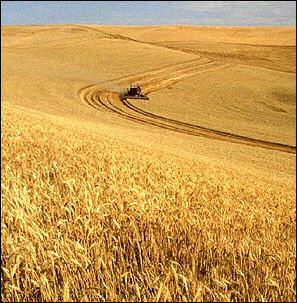
Wheat harvest Plowing releases carbon dioxide. Some farmer promote no-till farming. If farmers can plant seeds without tilling three quarters of a metric ton of carbon per acre could be stored every year.
The scarcity of rainfall in some agricultural areas has been attributed to climate change. So too has reduced corn and , wheat harvests. In 2011, AFP reported: “Climate change has stunted the worldwide increase in corn and wheat yields since 1980 by 3.8 and 5.5 percent respectively, according to a study in the journal Science. Without climate change, total harvests of both crops would have been significantly larger than they were, the statistical analysis found. [Source: AFP, May 7 2011]
The shortfall equals the annual yield of corn in Mexico, some 23 metric tonnes, and wheat in France, about 33 metric tonnes. One of the country's with the largest crop loss was Russia, where wheat production fell some 15 percent. The study estimates that the global drop-off in production may have caused a six percent hike in consumer food prices since 1980, some $60 billion per year. Net impact on rice and soybean was insignificant, with gains in some countries balancing losses in others, according to the study.
The researchers, led by David Lobell of Stanford University, noted one "startling exception": the United States isn't getting hotter, nor are its crop yields less than they might have been without climate change. "The results are a reminder that while the relationship between crop production and climate change is obvious on a global scale, models that zoom in... on a country-by-country basis won't necessarily see the same effects," the researchers said in a press release. To carry out the study, Lobell and colleagues compared two mathematical models, one tracking actual increases in temperatures and the other projecting 1980 temperatures over the next three decades.
Some argue that climate change will have positive affects on agriculture. Milder winters caused by climate change could extend the growing season and increase crop yields. Higher levels of carbon dioxide could “fertilize” crops. Faster composition may add more nitrogen and phosphorus to the soil adding to the fertilizing effect.
Climate Change and Fires

Changes in climate indicators
that show climate change Intense fires in Australia in 2019, California in 2020 and British Columbia in 2021 caused by very hot and dry conditions has led many to point the finger at climate change for at least being partly the villain.
Christopher J White wrote in The Conversation: “Higher temperatures globally are likely to be driving the increase in wildfire frequency and duration. But modelling wildfires is difficult. Climate models don’t predict wildfires, and they cannot indicate when future extreme events will occur year-on-year. Instead, climate modellers focus on whether they are able to predict the right conditions for events like wildfires, such as high temperatures and strong winds. [Source: Christopher J White, Senior Lecturer in Water & Environmental Engineering, University of Strathclyde, The Conversation, September 8, 2020]
“And these climate model projections show that the kind of extreme summer temperatures that weren’t likely to occur until the mid-21st century, exceeding predictions by decades. So even though an increasing trend of high temperatures and conditions suitable for wildfires are predicted in climate models, it’s alarming that these fires are so severe, have occurred in the same region two years in a row, and were caused by conditions which weren’t expected until further in the future.
Image Sources: Wikimedia Commons
Text Sources: New York Times, Washington Post, Los Angeles Times, Times of London, Yomiuri Shimbun, The Guardian, National Geographic, The New Yorker, Time, Newsweek, Reuters, AP, Lonely Planet Guides, Compton’s Encyclopedia and various books and other publications.
Last updated November 2025
